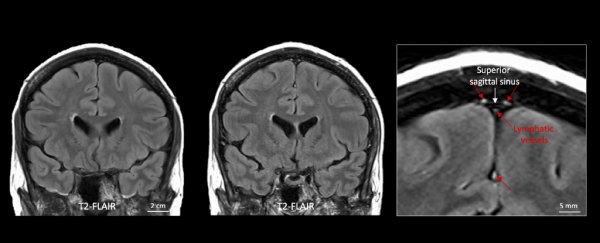Running through your body is a network of channels and junctions called the lymphatic system, which siphons off waste and fluids like a biological sewer.
It was long thought the brain was excluded from this web of anatomical plumbing. After being spotted in mice brains two years ago, researchers have now confirmed the presence of lymphatic vessels in human brains, fueling speculation over the kinds of diseases they might be responsible for.
Way back in 1816, an Italian anatomist by the name of Paolo Mascagni saw what he thought were lymphatic vessels running across the human brain of the cadavers he was dissecting.
If he did, his eyesight was stellar – in spite of two centuries of searching, nobody else could find them.
The lymphatic system is made up of branching vessels transporting white blood cells in a clear fluid called lymph around the body.
Its purpose is to keep the fluids between tissues moving and provide easy access for the immune cells to maintain law and order deep inside our tissues.
The fact that nobody could replicate Mascagni's discovery wasn't exactly a perplexing mystery. A dense wall of cells called a blood-brain barrier separates the circulatory system from our grey matter, helping to protect it from potential nasties.
While most organs in the body have a tight working relationship with the cells of the immune system, the brain is like a delicate piece of art kept behind glass.
The absence of tiny drainage pipes keeping our nervous tissue clear of filth, pathogens, and debris just added to the belief that the brain was a special case in anatomy.
It did prompt one niggling question.
White blood cells were known to wander the brain's corridors in search of intruders. How the hell did they get in and out?
In 2015, that question finally got an answer. By studying the brains of mice, American researchers finally identified the presence of a lymphatic system in the mammalian central nervous system.
They reported seeing "potentially similar" structures in the dura – the nervous system's tough outer membrane – of human cadavers, but the jury was still out.
A lecture given by the study's lead researcher, Jonathan Kipnis, got the attention of neurophysiologist Daniel S. Reich from the National Institute of Health in the US.
"I was completely surprised. In medical school, we were taught that the brain has no lymphatic system," said Reich.
"After Dr Kipnis' talk, I thought, maybe we could find it in human brains?"
To find them, the team injected five healthy volunteers with a contrasting agent called gadobutrol, and then scanned their brains using magnetic resonance imaging (MRI).
This made the dura visible, but alas, there was no sign of a lymphatic system.
MRI scans can be tweaked so the radio pulses vary in timing or with respect to the time they take echo. Different weightings of these measures can reveal subtle differences in anatomical features.
When Reich and his team used a different tuning on the MRI the blood vessels faded, leaving signs of another arrangement of channels they imagined to belong to a lymphatic system.
To make sure, they used another dye made up of molecules that were too big to leak out of blood vessels.
Sure enough, when they repeated their tuning, all signs of the mysterious lines were gone.
The team constructed a 3D rendering of one of the channels in one volunteer's brain, which you can check out below.

The same results were confirmed in marmoset monkeys, and physical evidence of the vessels were also detected in the dura of autopsied human brain tissue.
All up, the case of the brain's missing lymphatic system seems to be fairly solid.
"For years we knew how fluid entered the brain. Now we may finally see that, like other organs in the body, brain fluid can drain out through the lymphatic system," says Reich.
The next step for researchers is to study variations in this drainage system to see if they can help explain deeper health conditions.
"These results could fundamentally change the way we think about how the brain and immune system inter-relate," said Walter J. Koroshetz, NINDS director.
This research was published in eLife.
